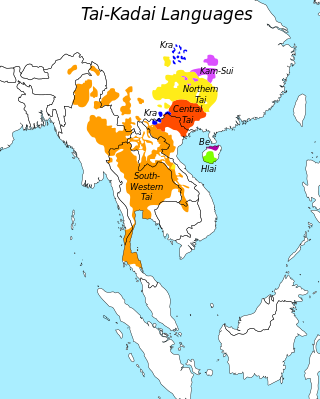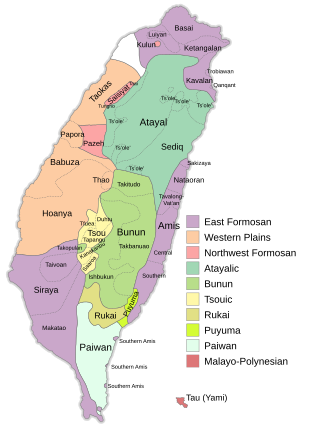Related Research Articles

Altaic is a controversial proposed language family that would include the Turkic, Mongolic and Tungusic language families and possibly also the Japonic and Koreanic languages. Speakers of these languages are currently scattered over most of Asia north of 35° N and in some eastern parts of Europe, extending in longitude from Turkey to Japan. The group is named after the Altai mountain range in the center of Asia. The hypothetical language family has long been rejected by most comparative linguists, although it continues to be supported by a small but stable scholarly minority. The research on their supposedly common linguistics origin has inspired various comparative studies on the folklore and mythology among the Turks, Proto-Mongols and Tungus people.

Sino-Tibetan, also cited as Trans-Himalayan in a few sources, is a family of more than 400 languages, second only to Indo-European in number of native speakers. The vast majority of these are the 1.3 billion native speakers of Chinese languages. Other Sino-Tibetan languages with large numbers of speakers include Burmese and the Tibetic languages. Other languages of the family are spoken in the Himalayas, the Southeast Asian Massif, and the eastern edge of the Tibetan Plateau. Most of these have small speech communities in remote mountain areas, and as such are poorly documented.

The Kra–Dai languages are a language family in Mainland Southeast Asia, Southern China and Northeast India. All languages in the family are tonal languages, including Thai and Lao, the national languages of Thailand and Laos respectively. Around 93 million people speak Kra–Dai languages, 60% of whom speak Thai. Ethnologue lists 95 languages in the family, with 62 of these being in the Tai branch.
Language isolates are languages that cannot be classified into larger language families. Korean and Basque are two of the most common examples. Other language isolates include Ainu in Asia, Sandawe in Africa, and Haida in North America. The number of language isolates is unknown.

The Formosan languages are a geographic grouping comprising the languages of the indigenous peoples of Taiwan, all of which are Austronesian. They do not form a single subfamily of Austronesian but rather nine separate subfamilies. The Taiwanese indigenous peoples recognized by the government are about 2.3% of the island's population. However, only 35% speak their ancestral language, due to centuries of language shift. Of the approximately 26 languages of the Taiwanese indigenous peoples, at least ten are extinct, another four are moribund, and all others are to some degree endangered.

Uto-Aztecan, Uto-Aztekan or Uto-Nahuatl is a family of indigenous languages of the Americas, consisting of over thirty languages. Uto-Aztecan languages are found almost entirely in the Western United States and Mexico. The name of the language family was created to show that it includes both the Ute language of Utah and the Nahuan languages of Mexico.

The fifteen Katuic languages form a branch of the Austroasiatic languages spoken by about 1.3 million people in Southeast Asia. People who speak Katuic languages are called the Katuic peoples. Paul Sidwell is the leading specialist on the Katuic languages. He notes that Austroasiatic/Mon–Khmer languages are lexically more similar to Katuic and Bahnaric the closer they are geographically. He says this geographic similarity is independent of which branch of the family each language belongs to. He also says Katuic and Bahnaric do not have any shared innovations, so they do not form a single branch of the Austroasiatic family, but form separate branches.
John D. Bengtson is an American historical and anthropological linguist. He is past president and currently vice-president of the Association for the Study of Language in Prehistory, and has served as editor of the journal Mother Tongue. Since 2001 he has been a member/researcher of Evolution of Human Languages, an international project on the linguistic prehistory of humanity coordinated by the Santa Fe Institute. His areas of specialization include Scandinavian languages and linguistics, Indo-European linguistics, Dené–Caucasian (Sino-Caucasian) languages, and paleolinguistics.
The Kuki-Chin–Naga languages are a geographic clustering of languages of the Sino-Tibetan family in James Matisoff's classification used by Ethnologue, which groups it under the non-monophyletic "Tibeto-Burman". Their genealogical relationship both to each other and to the rest of Sino-Tibetan is unresolved, but Matisoff lumps them together as a convenience pending further research.
The Naga languages are a geographic and ethnic grouping of languages under the Kuki-Chin-Naga languages, spoken mostly by Naga peoples.
The Tangkhulic and Tangkhul languages are a group of Sino-Tibetan languages spoken mostly in northeastern Manipur, India. Conventionally classified as "Naga," they are not clearly related to other Naga languages, and are conservatively classified as an independent Tangkhul–Maring branch of Tibeto-Burman, pending further research.
The Zemeic, Zeme, or Zeliangrong languages are a branch of Sino-Tibetan languages spoken mostly in Indian state of Nagaland, Assam and Manipur in northeast India. It may have close relationship with other Naga languages pending further research. The corresponding ethnic group is the Zeliangrong people. There were 63,529 Zeliang-speaking people in India in 2011.
Proto-Tibeto-Burman is the reconstructed ancestor of the Tibeto-Burman languages, that is, the Sino-Tibetan languages, except for Chinese. An initial reconstruction was produced by Paul K. Benedict and since refined by James Matisoff. Several other researchers argue that the Tibeto-Burman languages sans Chinese do not constitute a monophyletic group within Sino-Tibetan, and therefore that Proto-Tibeto-Burman was the same language as Proto-Sino-Tibetan.
Proto-Uto-Aztecan is the hypothetical common ancestor of the Uto-Aztecan languages. Authorities on the history of the language group have usually placed the Proto-Uto-Aztecan homeland in the border region between the United States and Mexico, namely the upland regions of Arizona and New Mexico and the adjacent areas of the Mexican states of Sonora and Chihuahua, roughly corresponding to the Sonoran Desert and the western part of the Chihuahuan Desert. It would have been spoken by Mesolithic foragers in Aridoamerica, about 5,000 years ago.
Proto-Athabaskan is the reconstructed ancestor of the Athabaskan languages.
Champhung is a Tangkhulic language known only from a wordlist provided by Brown (1837).
The language of the neighboring villages of Kaachai and Padāng in Manipur, India, constitute a Tangkhulic language. It is spoken by about 3,000 people in Kachai village, west-central Ukhrul District. Phadāng is only attested from 1859.
Huishu is a Tangkhulic language spoken in Huishu village, Ukhrul District, Manipur, India.
The Moklenic or Moken–Moklen languages consist of a pair of two closely related but distinct languages, namely Moken and Moklen. Larish (1999) establishes the two languages as forming two distinct subgroups of a larger Moken–Moklen branch. Larish (2005) suggests Moklenic as an alternative name for Moken–Moklen, the latter term which was originally used by Larish (1999).
Proto-Karenic or Proto-Karen is the reconstructed ancestor of the Karenic languages.
References
- ↑ Mortensen, David. 2014. The Tangkhulic Tongues - How I Started Working on Endangered Languages.
